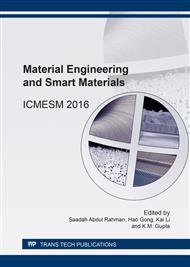p.8
p.14
p.23
p.28
p.33
p.37
p.45
p.52
p.56
Physico-Chemical Properties of CuO Thin Films Deposited by Spray Pyrolysis
Abstract:
Our work consists to the deposition of copper oxide (CuO) thin films onto glass substrates by the spray pyrolysis method. The precursor solution was copper chloride of 0.1 M and the deposition rate was 5 ml/h. The time of spray varied between 5 and 20 min and the substrate temperature was kept at 350°C. The structural, optical and electrical properties of CuO films were investigated, as a function of the spray time, by X-ray diffraction (XRD), Raman scattering, UV-visible spectroscopy in addition to the measurements of the thickness and the electrical resistivity. The obtained results indicated that our films were polycrystalline with a preferential orientation along the (111) planes. The peaks intensity as well as the grain size increased as a function of the spray time indicating the improvement of the films crystalline structure. The Raman spectroscopy confirmed the formation of the CuO phase. The UV-visible transmission varied between 36% and 53% and the band gap energy decreased from 2 to 1.72 eV as a function of the spray time. The electrical resistivity of the films decreased from 514 to 72 kΩcm and correlated with the decrease of the band gap energy and the increase of the grain size.
Info:
Periodical:
Pages:
33-36
Citation:
Online since:
March 2017
Authors:
Keywords:
Price:
Сopyright:
© 2017 Trans Tech Publications Ltd. All Rights Reserved
Share:
Citation:


